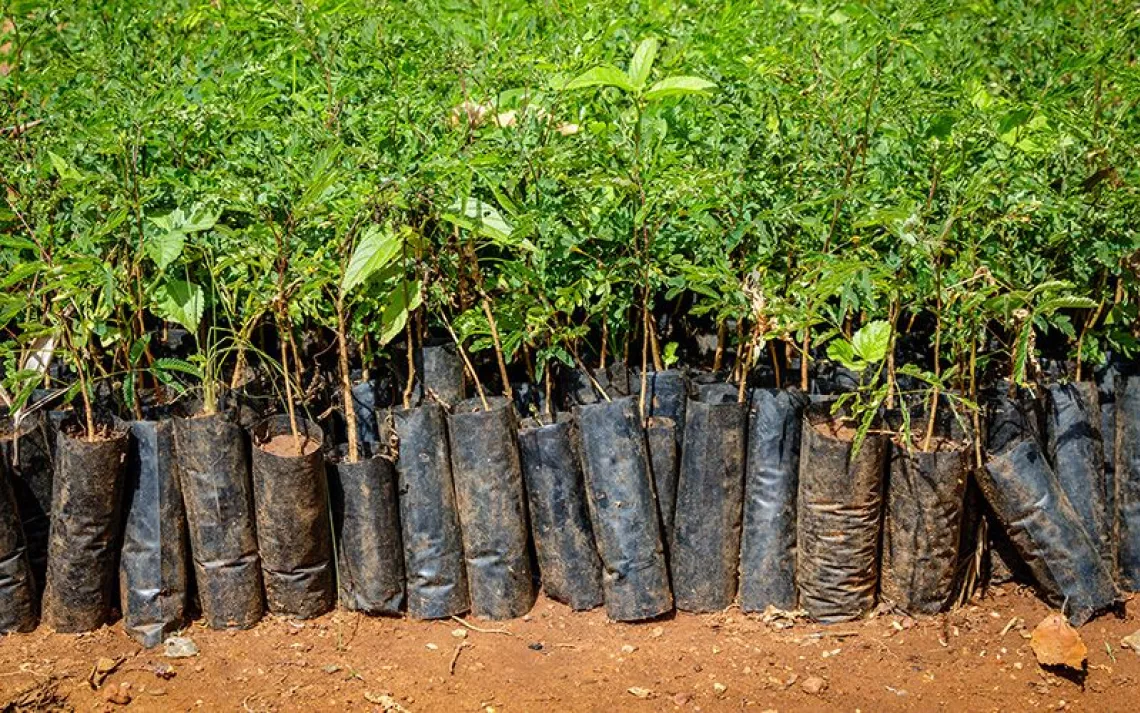Green Buildings Turn Kids Into Better Students
Schools that embrace eco-design and provide access to nature are teaching the next generation to care about the planet

Sierra House Elementary, in South Lake Tahoe, California, sports two growing domes. | Photo Courtesy of Jonathan Cook-Fisher
It's spring in South Lake Tahoe, California, and the snow is just beginning to melt. Ten second-graders are huddled inside a 10-by-10 geodesic dome, furiously scribbling. They ran through the wooden door laughing and giggling just five minutes ago, but now? Now they are silent. Some sit on garden boxes. Others try to glimpse the fish swimming in the aquaponic tank in the corner. There is magic here, a kind of alchemy that turns rowdy seven-year-olds into thoughtful scientists.
This is one of two geodesic garden domes at Sierra House Elementary, a public K–6 school. Throughout the year, students help to plant and harvest food in these domes, which help stock a weekly salad bar for the kids.
Denise Pillsbury, who teaches this group of second-graders, says that these 15-minute excursions to the domes, taken two to three times per week, help keep her class calm. The kids have their notebooks with them today for a botany lesson (they also regularly attend science and vocabulary classes in the domes), and they sketch and write what they see, in most cases correctly identifying everything from amaranth to rosemary.
Programs like this are springing up throughout the country as more schools embrace "biophilic design"—incorporating nature into architecture. In the case of schools, when completely redesigning classrooms is not an option (and it rarely is, especially for cash-strapped public schools), administrators are opting to add features like school gardens, rooftop solar, or greenhouses. In some cases, biophilic design is as simple as replacing asphalt with grass and concrete with flowerpots. In other cases, it's more complex and can involve remodeling or building new classrooms to take advantage of natural light and run on renewable energy.

A third-grader is hands-on in the Sierra House pollinator garden. | Photo Courtesy of Michelle McLean
Researchers are finding that even small steps toward incorporating nature into students' days result in many benefits, including behavioral improvements, a tendency toward environmental responsibility and, perhaps most importantly for schools, higher test scores and improved graduation rates. A recent Carnegie Mellon study found that students scored 20 to 26 percent higher on tests taken in classrooms with ample natural light. Another study, conducted at the University of Technology Sydney, found that just having plants in the classroom can improve math, science, and spelling performance by 10 to 14 percent. Students at greener schools tend to learn more about—and care more about—the environment, an effect that seems to last.
"My kid did kindergarten and first grade in a very, very green school in Marin [County]," says Adryenn Ashley, whose son is now 12 and being homeschooled in Reno. "They didn't kill bugs. They lovingly scooped them up and brought them to the garden. Try leaving the water on while brushing your teeth—kiddo will protest. He recycles and cares for all living things. All this is a remnant from his early school days."
That kind of lingering impact is precisely what Laura Cole, a University of Missouri researcher who studies how green schools affect students, has found. In her most recently published study, Cole proved that kids who go to school in buildings designed to be green are more knowledgeable about energy efficiency and environmentally friendly building practices.
That's not necessarily a huge surprise. But Cole also found that even schools with the greenest of buildings are failing to incorporate their building design ideals into the day-to-day curriculum. "They may have a lesson here or there,” she says, “or point to a south-facing window at some point during the day, but it’s pretty incidental.”

Parents and students explore newly built domes during the first Dome Open Night. | Photo Courtesy of Brian Lowe
Despite a lack of formal curriculum around things like energy efficiency or the benefits of natural light, students learn at least some of the good things about green building, Cole says. "They pick up on stuff that's near and dear to them, which tends to be mostly plants and animals. So what they really notice are aspects of the building that foster nature—that help with habitat for insects or animals, or get a plant growing up the wall, for example. With a turbine or solar panels, they tend to think of it as this thingy on the roof unless teachers go out of their way to incorporate a lesson about those aspects of the building."
That finding is important both for schools that are investing in green buildings and for those that don't have the money for a full-scale renovation. For the former, Cole's research points to the importance of incorporating a green-building curriculum into the plan for a green school. For the latter, it supports the idea that even inserting nature into students' days in small ways can increase their awareness of the environment and deliver academic benefits.
In Cole’s recent survey of five middle schools around the country, she was surprised to find that the school with the fewest green features had some of the most eco-minded students. "It was a Waldorf school, and they were significantly more likely to be seeing and participating in various environmentally responsible behaviors at home," Cole says. "So if you're getting that educational exposure to environmental issues somewhere, whether at home or at school, it sticks with you."
In other words, though learning in a green building helps to underscore various environmental science lessons, and access to nature and sunlight are proven to boost grades and participation, you don't necessarily need a million-dollar eco-school to achieve those results.
Tahoe’s Sierra House is the green-school dream come to life: It costs the school nothing, not even to maintain (it’s 100 percent funded by donations), but has touched every aspect of the curriculum and has benefitted the local community. "These kids go home and tell their parents, ‘We should buy some kale and carrots at the store,’" Principal Ryan Galles says. "And all of a sudden you have families that maybe weren't eating that healthy before shifting their diets because their kids are bringing home new information, or trying things at school that they like and want to introduce to their family."
But it's the rare school that hits so many strokes of good luck. According to Cole, attempts to bring biophilic design to K–12 schools are tough to fully realize.
"What tends to happen is that there's one champion at the school, either a teacher or a parent, who's super passionate about it," Cole says. "They get the money together and really make things happen."
For Sierra House, that champion was Michelle McLean, a parent with a keen interest in gardening. When she first moved to the United States from her native Scotland, she worked for the U.S. Forest Service as a field archaeologist. Shortly after moving to South Lake Tahoe, she got certified as a master gardener from the University of California at Davis. It was through that program that she learned about a geodesic greenhouse in Truckee, California, that had been designed to grow food in alpine conditions.
"A group of us drove over to tour it, and I thought, 'We need one of these in South Lake,'" she remembers. "But we couldn't find the land for one. So then we thought, ‘Well, why don't we see if the school would be interested?’"
Principal Galles was interested, but the school had no budget for a gardening program, much less $25,000 for the growing domes. So McLean and a handful of parents and teachers started fundraising. Eventually they raised enough money to cover the cost of not only the domes but also the plants, soil, and aquaponic equipment.
The local chapter of Soroptimist (an international organization working to improve the lives of women and girls) ponied up the cash for the domes. Once that happened, individual contributions started pouring in. Parents donated their time and skills to construct the domes. McLean has continued to apply for grants and run fundraising campaigns to keep the gardening program expense-free for the school. She even raised enough to carve out a paid job for herself running the program.
According to Cole, what gives a school like Sierra House a good shot at continued success at environmental education is the fact that its program is formally integrated into the curriculum. "If it doesn't get embedded into the school—particularly the curriculum—and then that person who originally championed the idea leaves? All that work goes to waste," she says.
Gardens and food are often schools’ entry point into sustainability. But Margaret Lamar, who leads the Children and Nature Network's Green Schoolyards program, emphasizes another important aspect of how kids develop a relationship with nature: play.
"Let's say you take a group of little kids to a creek,” she says. “If the water’s running, they can see that all the plants around the creek are being fed by that water. If it's dry, they might see roots poking out along the sides. And they might touch them, jump on them, and run around the creek bed. There's no formal lesson there. But then years later, when they learn about erosion in fourth grade, it makes sense to them because they saw what was happening to that tree in that creek bed."
Kids who have those sorts of fun experiences early on grow into adults who understand the natural environment and care about it, according to Lamar.
She adds that school buildings are "hugely important," and those that offer even the simplest aspects of biophilic design—natural light and glimpses of trees—are linked to higher test scores and improved graduation rates. "Being able to see sunlight and greenery,” she says, “gives you access to nature in ways that reduce stress and improve mental health.”
Amid dwindling school budgets, Lamar says, gardens are a realistic, low-cost way for institutions to connect kids with nature. "You can start pretty small, and it doesn't require ripping up any concrete if you use garden beds," she says.
Cole's research backs this up. "Anything educators can do to utilize existing space can help their students’ green-building literacy," she says.
For Cole, that literacy is as important as improved test scores or reduced absences. “We all use buildings every day," she says. "Our children will soon be the people buying and constructing homes, offices, and other buildings. Learning and translating that knowledge into future green building design will play a huge part in solving our environmental problems.”
The Holy Grail in all this, Lamar adds, is replicability. "If I could say, 'Look at these three schools. This is how you do it. Let's just replicate that everywhere,' that would be fantastic," she says. "But in a lot of cases, it's very context-specific and has a lot to do with the geography and the people and the resources involved."
To that end, the Children and Nature Network (childrenandnature.org), which was cofounded by Richard Louv, is assembling a strategy team to examine what kinds of policies, programs, and partnerships are needed to give all students access to nature.
Meanwhile, most schools will continue to rely on the efforts of that one devoted science teacher or gardening parent.
"The next thing I really want to do,” McLean says, “is get carts that we can move around from class to class so we can show the kids how to cook with these things they see growing—that gets into chemistry and how and why different things react. It would be great! We just need to figure out how to fund it."
 The Magazine of The Sierra Club
The Magazine of The Sierra Club



